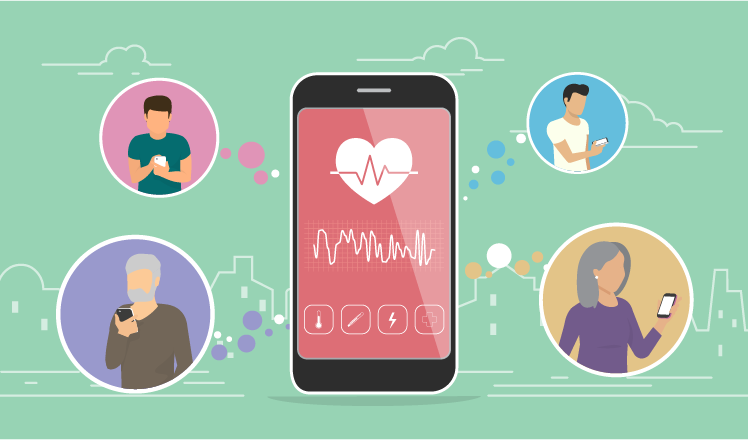Top 3 general mHealth apps to keep heart failure patients away from ERs
This article examines three general mobile healthcare apps that, through thoughtful development, offer heart failure patients practical tools for daily self-management. These apps illustrate how well-designed mHealth solutions can help reduce ER visits by empowering patients to take control of their health.
In the previous article, we scored top 4 heart failure-specific apps against a 40-point scale and had our winner. But we couldn’t just stop on specialized patient apps because there are some functionality-rich mHealth solutions that can also help the patients with heart failure to manage their condition daily. Therefore, we dived into the pool of health applications with features relevant for HF self-management and picked up 3 promising options. Then we analyzed them according to the scoring guidelines below and found what they have to offer.

Score guidelines
Each app can gain maximum 40 points. These points are divided into 4 categories, covering functionality, synchronization with devices and other apps, sharing capabilities and patient-provider communication. Here’s how the points are distributed:
- Functionality musts – 20 points max
- HF-focused therapeutic education (5 max)
- HF-critical vitals recording and analysis (5 max)
- Medication tracking (5 max)
- Appointment scheduling (5 max)
- Smart sync – 5 points max
- Device sync (3 points)
- App sync (2 points)
- Sharing – 5 points max
- Yes/no
If yes, what type of sharing is enabled:
- Automatic (3 points) and/or manual (2 points)
- Communication – 10 points max
- Yes/no
If yes, what type of communication is available:
- Text communication (2 points)
- Voice communication (3 points)
- Video communication (5 points)
Now, let’s look at the top 3 according to our scoring.
Symple
The app plans to cover Android in the future, but only Apple users can benefit from Symple at the moment. The application’s strength is in the analysis, it wants a patient to be as condition-savvy as possible. Particularly, Symple offers the following functionality:
- Interactive journal: the place for patients to store thoughts, concerns and factors that influence his or her wellbeing. Particularly, the patient can record the things he or she does or experiences, such as yoga, new diet, an important event and more.
- Apple Health sync: this synchronization allows patients to access data from the Health app, including steps, sleep, nutrition and activity records. As Health also allows integration with smart devices, an HF patient can potentially measure their needed vitals and see the trends within Symple.
- Symptom trends: patients can input any symptoms, such as a headache, edema or troubled breath, and monitor their recurrence, reminding themselves to do it daily or weekly if needed. The absence of a particular symptom is also tracked to construct a more accurate trend line.
- Medications: patients can track their medications by either taking a photo of their current intake or recording them in freetext. The app then creates graphs so that the patient could view how medications affect their symptoms.
- Doctor report: it is practically a notepad with an overview of the patient’s concerns. Data get into the report from the journal and symptoms (if tagged). The patient can also add them manually.
Final score: 14 / 40
Outtake. Now yes, the question is obvious – how the app with such a low score got into the top 3? Symple doesn’t focus on any particular patient category and doesn’t connect the patient with their provider, nor does it allow sharing. Practically, these are the reasons the app scored so low: it was 12 points initially.
But it has a few pros and valuable ideas that added two more bonus points and brought the app to this list. By being simple yet very analytic, the app keeps the patient organized by reminders, doctor report and interactive journal. It also offers the patient a graphical representation of symptoms and factors and their correlation with medications across different time frames. This feature can identify a nonfitting medication or physical activity.
Besides, the patient can show the graph to their provider during the next appointment, using the doctor report to build an informative and useful conversation. Moreover, due to synchronization with the Health app, Symple can also analyze the vitals, if they were added to Health.
It is a long way, but still, the app can support HF patients in their self-management goals. Practically, all that this app needs is a solid connection to providers, and they are good to go.
WebMD
WebMD is an app designed to become the patient’s personal guide in healthcare. The app allows:
- Symptom tracker: the tool to identify possible causes of arising symptoms.
- Health check: the patient can enter their weight, systolic and diastolic blood pressure and total cholesterol with HDL, LDL and triglycerides.
- App sync: integrates with other health apps (for example, Apple's Health) to ensure a better overview of patient’s well-being. It's possible to track sleep, nutrition, additional vitals and overall activity.
- Help locator: in case the patient enters symptoms that can indicate serious or life-threatening conditions, the app will suggest visiting a doctor nearby or navigate the patient to the nearest emergency room.
- Health tips: the patient can get a set of hints for their condition, heart failure, in our case. These hints cover the explanation of risks, list of basic medications, medical procedures, complementary therapies and self-care strategies. These strategies can include fluid monitoring, low-salt diet and more. Moreover, the patient can also watch a number of short videos with self-management guidelines. In case of need, the patient can also call their physician within the app.
- Appointments: composes a summary of the patient’s consultation from the health tips tab and highlights key information to discuss during the appointment.
- Medication tracker: helps to organize the medications.
- Images & videos: the patient can upload pictures and videos to share with their physician.
Final score: 22.5 / 40
Outtake. Despite not being a heart failure app, WebMD offers a set of functions that can help an HF patient to stick with the treatment plan, learn more about their condition and contact their provider in case of need (or locate the nearest emergency room).
With the initial score of 19.5 due to the inability of building trends in vitals and incomplete set of vitals critical for HF, the app gained three more points for interactive symptom analysis, help locator and summary composing. These features will help the patient to prepare for their follow-ups, ask informed questions and understand their current condition enough to ask for help timely.
iTriage
iTriage was created by a cognominal company, now Aetna’s wholly owned subsidiary. The app is designed by ER doctors and offers a substantial knowledge base of conditions and medications. This thorough base was even approved by Harvard Medical School.
But let’s look at the functionality in details:
- Care search: a tool to help patients find any facility, doctor or physician nearby or in a defined location. This tool can be used for searching medical assistance to address symptoms, treat a defined condition (HF in our case) or just navigate to the nearest facility of choice. Patients can also reference with an estimated cost information to understand upcoming expenditures.
- Conditions: here, an HF patient can choose their condition from the list and get a therapeutic education. In particular, the app highlights the condition’s description, related videos, most common symptoms, tests and possible medications. Each medication can be added to the patient’s profile, explained according to conditions treated, usage instructions, possible side effects and instructions on what to do if a patient forgets to take this medication or overdoses. Importantly, the patient can familiarize with the list of symptoms that are critical for heart failure and require immediate medical assistance (e.g., swelling in the abdomen area, difficulty in breathing and more).
- Symptoms pathway: the patient can search for symptoms separately by simply choosing an area of the male/female body in a picture. If a symptom selected can be life-threatening, the app will notify a patient and suggest him or her to find an ER or call 911 directly by clicking the assigned button.
- Health profile: the patient can see their Personal Health Records (PHRs) stored in Microsoft HealthVault, ActiveHealth Management and other portals that patient can easily add to their iTriage profile. As HealthVault supports synchronization with smart medical devices, it allows gathering all HF-specific vitals, such as blood pressure, pulse, weight and temperature.
- Appointments: within this feature, the patient can see confirmed, unconfirmed and past visits as well as add new appointments.
- Spotlight and news: a feed with educational materials with adjustable preferences.
- Hotlines: the patient can contact physician and nurse advice lines, call 911 or access additional hotlines, including domestic abuse, suicide, poison and non-emergency police hotlines.
Final score: 24.5 / 40
Outtake. This app has a huge potential. iTriage can help patients with heart failure (and not only) to understand what to prepare for – what treatment, procedures and symptoms can be expected in the future. With the initial score of 21.5, the app gained three more bonus points for valuable features. Specifically:
- A massive knowledge base approved by an authoritative source,
- a range of hotlines to assist a patient in various needs (especially if a condition leads to depression),
- a careful symptom analysis system that will indicate the need to seek immediate medical attention.
Still, iTriage lacks the ability to gather and analyze the vitals within the app and share this information with the patient’s PCP or other care team member. Video chats would be great as well.
Of course, these features extend the functionality of the app, which is probably not planned by the company. However, Aetna could push the integration, add visibility on the providers’ side within their health plan network and benefit greatly by offering their own self-management and readmission prevention tool.
Heart stoppers or life savers
General mHealth apps are not specially created heart disease apps, period. But the level of elaboration of details and features in these apps shows the overall crossbar that medical apps have reached. The apps that we reviewed are attentive to vitals and trends in symptoms. They allow emergency calls, help patients to structure their thoughts and questions prior to the next appointment, navigate to the nearest care point and warn about adverse effects. In summary, they hand the control of a patient’s health out to a patient.
In fact, such control is what health management is all about. What the reviewed apps need is a link to providers to close the care loop and make a step forward to telehealth at its best. After that, general apps will be able to compete with specific ones.


